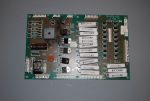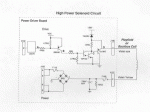This article was originally posted on PinballRehab.com.
Reproduced with permission from terryb.
Written by terry

A. Basic Electronics
B. Transistors
C. Integrated Circuits
D. Test Equipment
E. Operators Manual
F. Reading Schematics
G. Electronics Troublshooting
This is part seven of a seven part series intended to provide a basic knowledge of electronics, test equipment, pinball manuals and troubleshooting in order to allow the reader to effectively repair pinball games. With that goal in mind I have simplified the explanations and purposely glossed over some details that add no value, and can easily confuse beginners.
Good troubleshooting is both art and science and takes years to become proficient at. Even the best in the business really can’t explain why one person is a great troubleshooter and another is not. So while I can’t help with the art side of it, here’s a few of the lessons I’ve learned in 30 years of repairing high-end medical equipment like Blood Chemistry Analyzers, MRI’s and CAT Scanners, and of course pinballs.
Before you start you need to decide if you should be doing board rework or not. According to the pinball board repair shops an ever increasing percentage of the boards they get are unrepairable due to hack jobs. You won’t save any money if you have to buy a new board because the one you butchered can’t be repaired. Trust me, these 20-30 year-old boards are not easy to work on, even if you have years of soldering experience.
That doesn’t mean you won’t find value in this article though. Many repairs won’t require board rework and if it is a board problem at least you’ll know you’re sending the right board out for repair.
Resources
Before you get started you need to gather a few resources. This includes operator and service manuals for the game, a DMM and a logic probe (if you’re troubleshooting to component level). In addition you need to have a basic/intermediate understanding of electronics and should be familiar with the in-game diagnostics. There are also a lot of great resources on the web, but be aware some sites provide better information than others.
IMAGE GALLERY
Document
It’s very easy to get lost or confused during the troubleshooting process, especially if it spans a couple of days. Having notes to look back on, either written on a copy of the manual page, or in a notebook will help remind you of what you have tested, what you haven’t and what results you got.
Define the Problem
This may seem obvious, but all you have to do is read a few posts to realize that most people can’t even accurately describe the problem they are having. By the way, this is the first thing you will document and as you proceed with the following step you may even have to edit your definition.
Collect Information and Identify Symptoms
While you think you’ve already done this, you probably haven’t. Most people immediately jump in once they see a problem without taking the time to analyze the problem. Here’s a few questions you should ask yourself.
- Have I worked on the machine recently?
- Is it a pre-existing problem?
- Does the problem happen all the time, or is it intermittent?
- What is happening in the game at the time the problem occurs?
- Is there only one symptom, or more than one?
- If there are multiple symptoms, are they interrelated?
- Do the diagnostics provide any additional information?
- What other information can I collect?
For example, the symptoms relating to a lamp matrix problem will get you 90% of the way towards identifying the cause. Here”s the questions I immediately ask myself in this situation: Is only one lamp out? Is a whole row, or column, of lights out? Are two or three lights in a column or row out, but not all of them?
If the first answer is yes, it’s either a bulb or socket problem. If the second answer is yes it’s most likely a driver problem on the circuit board or the wiring from the circuit board to the playfield. If the third question is yes there is most likely a break in the playfield wiring between lamps.
Don’t forget the diagnostics and manual tables can give you valuable information like wire color, board connector and pin number, driver circuit and part identifier (unique number for that lamp, solenoid, etc.).
Human Induced Error
One thing I should mention first is human induced error. If you recently worked on the game, then you likely caused the problem. It might be directly related to what you did (replaced a connector) or indirectly. For example, you pulled on another connector while working in the area or you shorted two wires together.
I see all the time where pinballers swear they have double and triple checked their work only to find out later that they had made a mistake. The problem is we’re not very good at checking our own work. The brain will make the same mistake the second and third times that it did the first.
The best approach is to walk away and then come back later with a mindset that you are checking work done by someone else and you’re sure they did something wrong. Even though you know you wired that connector correctly, pull out the manuals and check all of the wire colors.
The other possibility is that the game is new to you and arrived with the problem. In this case, do not every rule out the stupiditiy of the person who worked on it before. I’ve found IC’s installed backwards, incorrect transistors installed, diodes backwards and a ton of bad soldering (both opens and shorts).
These are all things you will never find using standard troubleshooting techniques. You don’t expect a chip to be in backwards so you don’t look for it. In addition to checking things you wouldn’t normally consider you need to examine the entire circuit and look for areas where work has been done.
The Big Picture
The next thing I do is review the logic diagram for the problematic circuit. This gives me an overview of the circuit and let’s me consider my approach and develop a plan before I just start measuring everything. It’s also very easy to get lost in the weeds when troubleshooting and this higher level view will help keep you on track.
Five Senses
Using your senses is an often overlooked part of troubleshooting. For example, I can open up a backbox and immediately tell you if there is a fried resistor or capacitor based on the smell. When confronting a problem with a fuse blowing every time I turn on the game, I listen for the sound of a solenoid firing (and staying on).
One of the first indications of a resistor overheating is bubbling which you can feel with your fingers long before you can see it. You can also feel components that are running hot.
Probably the most important sense though is sight (see Burned Circuit Board, Image 1). Over the years I would bet at least 20% of the time I’ve found the cause of a problem just by doing a visual inspection of the circuit (use the logic diagram for this). Just a few of the things you might find: over-heated connector, component or solenoid, parts missing (yes, sometimes they just fall off) or a wire that is broken, loose or shorted.
Reproduce Symptoms
The next step is to make sure you can consistently reproduce the symptoms (diagnostics are great for this). Sounds simple, but there’s nothing worse than spending two hours troubleshooting a problem and then finding out your method of re-creating the problem wasn’t working.
Troubleshooting
Before you start troubleshooting you have a couple of choices. While some people like to test circuits serially, either starting at the beginning of a circuit and moving towards the end (or the opposite), I prefer to first divide the problem (see Image 2, High Power Solenoid Circuit).
In this case I would split the circuit into thirds: the power supply, the solenoid and wiring and the logic circuit. I always like to test supply voltage first so I would test the voltage at J107. If that was good I would then monitor the voltage at J130 while I used diagnostics to fire the solenoid.
Depending on the results I would then start testing the solenoid and wiring or the circuit board. In the case of the circuit board I would move to a serial method and start at the connector and move upstream (the failure will tend to be closer to the connector because the current is higher.
Image 3 is the motor and magnet circuit from Dracula, which while more complicated it still suits itself well to the “divide the problem” approach. How many pieces would you break it into?
The basic troubleshooting process is actually pretty simple, although you’re far ahead of the game at this point because most people skip all the previous steps and start here.
- Identify the test point.
- Measure the test point.
- Reproduce the problem.
- Evaluate the measurement.
- Move on to the next test point based on 4.
Basically, you change the input to see if the output changes. I’ve got a EE and not one thing I was taught helps me troubleshoot a transistor any better than an eight year-old with a DMM. All I need to know is, if I change the input and the output changes I can go on to my next test point. If the input changes and the output doesn’t change the transistor is bad.
Along those same lines, rather than getting hung up in the details of how an OR gate works, you can often just compare the circuit under test to a known good circuit. For example, the column 3 driver circuit has an exact replica right next to it; the column 4 driver circuit. Just change the input on each, while measuring the output ,and compare your results. Almost every circuit on a pinball game has one or more identical circuits.
One last point that may draw some ire. While testing a transistor with an ohmmeter is commonly recommended it really isn’t as good a test as measuring voltage. Plus it’s just as easy to test voltage as measure ohms. My general theory is the only time I use the ohms range, other than testing continuity or looking for a short, is once the board is removed from the game. (Actually even then I use a power supply, pulse generator, logic probe and DMM for testing, but most people don’t have that kind of setup.)
Just my opinion.
Impediments
While I can provide all the troubleshooting techniques in the world, my experience is that most of the time rather than not doing the right thing, people get hung up by doing the wrong thing. Here’s a few common mistakes I’ve seen over the years.
- Over thinking the problem: Remember Occam’s Razor; the simplest solution is most often the best.
- Lack of specific knowledge: You’re not sure how an AND Gate works.
- Jumping around: Not using a logical progression from point to point when testing.
- Wandered off the path: Got sidetracked and headed off down a good part of the circuit, or the wrong circuit.
- Making assumptions: Skipping a test because you “know” that part is good.
- Over-weighting recent history: The cause of the last solenoid problem is probably not the cause of this one.
- Lost in the weeds: Getting hung up in the details and losing sight of the bigger picture.
- Skipped steps: Didn’t progress through all the steps before beginning troubleshooting.
- Ignoring data: Skipping over symptoms or indications because they don’t fit your thought process.
- Panicking: This happens more than you would think, just relax it’s only a pinball game.
Take a Walk
Here’s a couple of tricks you can use when you’re completely stuck. First is walk away from the problem for a while. I have solved a ton of problems while going outside to have a cigarette. If that doesn’t work try talking to yourself; explain the problem and what you’ve done so far. The process of organizing your thoughts in order to explain them often leads to insights.
Intermittent Problems
There’s a reason they’re called intermittent problems, not random problems. Intermittent problems always have a cause, it’s just different. Heat or vibration (cold solder joints are a common problem on twenty some year old games) are the most common causes, but sometimes you just haven’t identified the pattern yet. I actually had the following problem occur on a pinball game.
A fuse would blow occasionally when the left kicker was energized. Not always, just sometimes. I finally observed this only happened when the top target in a four-bank drop target was down. What I found was when the top drop target was down it was pulling on, and shorting to ground, the return wire for the kicker.
Priorities
For almost any problem here’s the order of possible causes, from highest to lowest probability: connector/wiring, diode/transistor, IC and resistor/capacitor. While you do want to troubleshoot progressively, keep this order in mind.
Also, higher current devices are always more likely to fail than lower current devices. For example, many solenoid circuits use a driver and a pre-driver transistor. The driver transistor carries the high current so it is more likely to fail than the pre-driver.
There’s also a cost of repair that will help define your troubleshooting process. While you may suspect the IC on the board is blown, there are probably several other possibilities, although less likely, that you can check before spending a couple of hours remvoing a circuit board.
Secondary Failures
It is not uncommon for a failed component to blow other components. In the example above a failed driver transistor will often take out the pre-driver or sometimes even an IC. A shorted diode on a solenoid will often take out the IC that controls the solenoid. So don’t stop once you find the first problem, make sure the other parts of the circuit are working.
References
- The following is a great site that provides more in-depth electronic tutorials: All About Circuits.
- Randy Fromm’s YouTube Channel also has some great videos on basic electronics theory.
Comments
Comments, including general questions about electronics troubleshooting, suggestions, improvements, errors, etc. are welcome (see below).
If you have a specific question about your game, please see our FAQ section.


